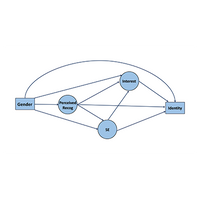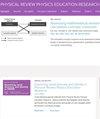具有不同因果结构的统计等效模型:物理学特性实例
IF 2.6
2区 教育学
Q1 EDUCATION & EDUCATIONAL RESEARCH
Physical Review Physics Education Research
Pub Date : 2024-01-16
DOI:10.1103/physrevphyseducres.20.010101
引用次数: 0
摘要
结构方程模型(SEM)是一种广泛应用于教育研究的统计方法,用于研究变量之间的关系。SEM 模型通常基于理论基础构建,并通过拟合指数进行评估。然而,仅有拟合度较高的 SEM 模型并不足以验证所提出模型的因果推论,因为在统计上存在具有不同因果结构的等效模型,它们同样能很好地拟合数据。因此,使用 SEM 的研究人员必须考虑统计学上的等效模型,并阐明为什么提出的模型比等效模型更准确。然而,许多 SEM 研究并没有明确解决这一重要步骤,之前的物理教育研究也没有深入探讨区分具有不同因果结构的统计等效模型的潜在方法。在本研究中,我们以物理身份模型为例,讨论考虑统计等效模型的重要性,以及其他数据如何帮助区分这些模型。以往的研究已经确定了物理认同的三个维度:感知认可、自我效能感和兴趣。然而,这些维度之间的关系尚未得到透彻的理解。在本文中,我们从对物理课程学生的个别访谈中得到启发,建立了一个由感知认可度预测自我效能感和兴趣的模型,以实现物理学习环境的公平性和包容性。我们用拟合指数检验了我们的模型,并讨论了感知认知、自我效能和兴趣之间不同因果推断的统计学等效模型。然后,我们讨论了一些潜在的实验,这些实验可以进一步对模型背后的因果推论进行实证检验,从而帮助完善更准确的因果模型,指导教育改进工作。本文章由计算机程序翻译,如有差异,请以英文原文为准。

Statistically equivalent models with different causal structures: An example from physics identity
Structural equation modeling (SEM) is a statistical method widely used in educational research to investigate relationships between variables. SEM models are typically constructed based on theoretical foundations and assessed through fit indices. However, a well-fitting SEM model alone is not sufficient to verify the causal inferences underlying the proposed model, as there are statistically equivalent models with distinct causal structures that equally well fit the data. Therefore, it is crucial for researchers using SEM to consider statistically equivalent models and to clarify why the proposed model is more accurate than the equivalent ones. However, many SEM studies did not explicitly address this important step, and no prior study in physics education research has delved into potential methods for distinguishing statistically equivalent models with differing causal structures. In this study, we use a physics identity model as an example to discuss the importance of considering statistically equivalent models and how other data can help to distinguish them. Previous research has identified three dimensions of physics identity: perceived recognition, self-efficacy, and interest. However, the relationships between these dimensions have not been thoroughly understood. In this paper, we specify a model with perceived recognition predicting self-efficacy and interest, which is inspired by individual interviews with students in physics courses to make physics learning environments equitable and inclusive. We test our model with fit indices and discuss its statistically equivalent models with different causal inferences among perceived recognition, self-efficacy, and interest. We then discuss potential experiments that could further empirically test the causal inferences underlying the models, aiding the refinement to a more accurate causal model for guiding educational improvements.
求助全文
通过发布文献求助,成功后即可免费获取论文全文。
去求助
来源期刊

Physical Review Physics Education Research
Social Sciences-Education
CiteScore
5.70
自引率
41.90%
发文量
84
审稿时长
32 weeks
期刊介绍:
PRPER covers all educational levels, from elementary through graduate education. All topics in experimental and theoretical physics education research are accepted, including, but not limited to:
Educational policy
Instructional strategies, and materials development
Research methodology
Epistemology, attitudes, and beliefs
Learning environment
Scientific reasoning and problem solving
Diversity and inclusion
Learning theory
Student participation
Faculty and teacher professional development
 求助内容:
求助内容: 应助结果提醒方式:
应助结果提醒方式:


